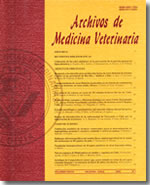Determinación del riesgo potencial de estrés térmico del ganado bovino en cuatro localidades del centro y sur de Chile
Contenido principal del artículo
Resumen
Datos climáticos del periodo diciembre a febrero de los años 1999 al 2007 provenientes de estaciones meteorológicas situadas en Curicó, Chillán, Temuco y Osorno fueron utilizados para calcular un índice temperatura-humedad ajustado por el efecto del viento y de la radiación (THIadj-max). Las variables climáticas utilizadas para calcular este índice incluyeron: velocidad del viento, temperatura máxima del aire, humedad relativa y un valor estimado de la radiación solar. Cuando los valores de THIadj-max fueron superiores a 75, estos días fueron considerados como indicadores de "alerta" y riesgo potencial de estrés térmico en el ganado. Adicionalmente, el impacto en la producción animal fue estimado sobre la base de pérdidas potenciales de producción de leche para cada localidad, utilizando dos ecuaciones para su estimación. Las localidades de la región central, Curicó y Chillán, presentaron valores promedios de THIadj-max similares (79,4 y 79,1, respectivamente), pero ambos superiores a las de la región sur (Temuco y Osorno 77,1 y 68,1, respectivamente; P < 0,05). La probabilidad de días con THIadj-max > 75 fue mayor en la región central. Asimismo, la producción de leche mostró un mayor potencial de pérdidas en las regiones centrales de Chile (1,5 a 4,3 y 1,2 a 3,6 L*vaca-1*d-1 para Curicó y Chillán, respectivamente). Por otra parte, las regiones del sur, Temuco y Osorno, presentaron menores pérdidas potenciales (0,9 a 2,6 y 0,1 a 0,6 L*vaca-1*d-1, respectivamente). En conclusión, el riesgo potencial de estrés térmico para el ganado bovino es mayor en Curicó y Chillán, es moderado en Temuco, y es mínimo en Osorno. Finalmente, la cuantificación del impacto directo que tiene el clima sobre la productividad y el bienestar de los bovinos en Chile necesita ser estudiada.

